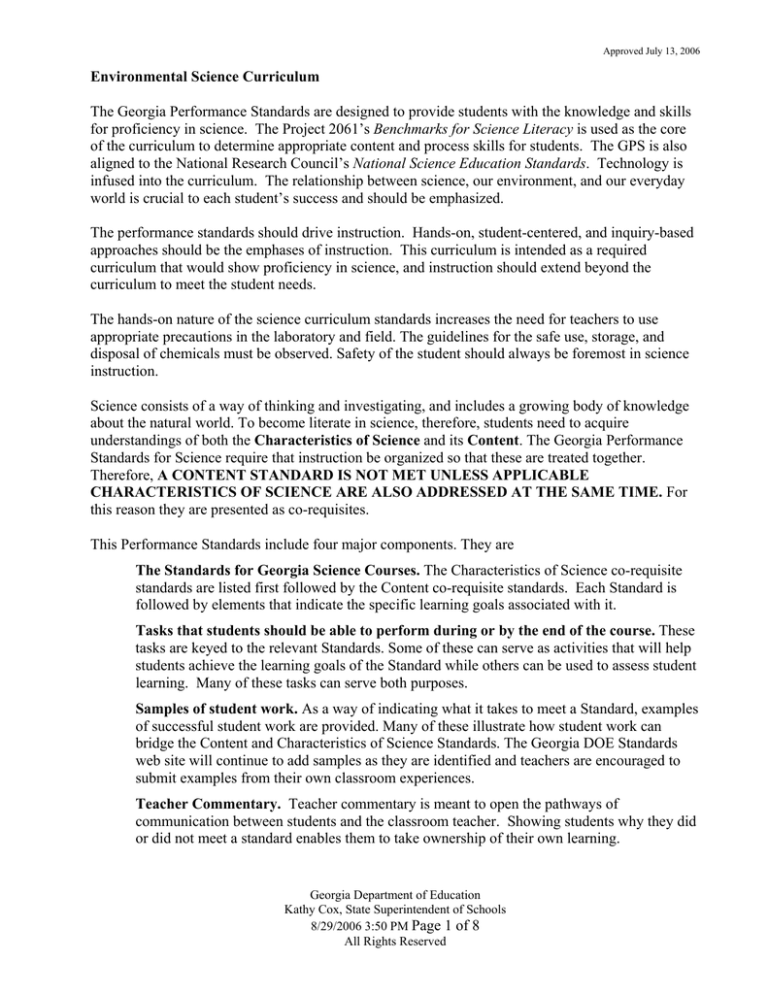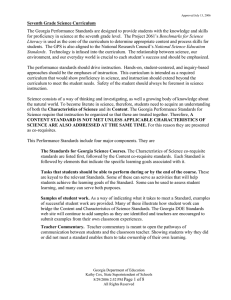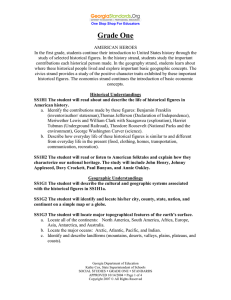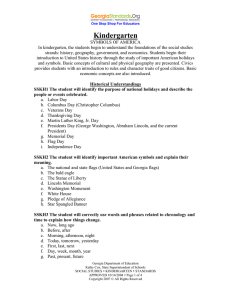
Approved July 13, 2006
Environmental Science Curriculum
The Georgia Performance Standards are designed to provide students with the knowledge and skills
for proficiency in science. The Project 2061’s Benchmarks for Science Literacy is used as the core
of the curriculum to determine appropriate content and process skills for students. The GPS is also
aligned to the National Research Council’s National Science Education Standards. Technology is
infused into the curriculum. The relationship between science, our environment, and our everyday
world is crucial to each student’s success and should be emphasized.
The performance standards should drive instruction. Hands-on, student-centered, and inquiry-based
approaches should be the emphases of instruction. This curriculum is intended as a required
curriculum that would show proficiency in science, and instruction should extend beyond the
curriculum to meet the student needs.
The hands-on nature of the science curriculum standards increases the need for teachers to use
appropriate precautions in the laboratory and field. The guidelines for the safe use, storage, and
disposal of chemicals must be observed. Safety of the student should always be foremost in science
instruction.
Science consists of a way of thinking and investigating, and includes a growing body of knowledge
about the natural world. To become literate in science, therefore, students need to acquire
understandings of both the Characteristics of Science and its Content. The Georgia Performance
Standards for Science require that instruction be organized so that these are treated together.
Therefore, A CONTENT STANDARD IS NOT MET UNLESS APPLICABLE
CHARACTERISTICS OF SCIENCE ARE ALSO ADDRESSED AT THE SAME TIME. For
this reason they are presented as co-requisites.
This Performance Standards include four major components. They are
The Standards for Georgia Science Courses. The Characteristics of Science co-requisite
standards are listed first followed by the Content co-requisite standards. Each Standard is
followed by elements that indicate the specific learning goals associated with it.
Tasks that students should be able to perform during or by the end of the course. These
tasks are keyed to the relevant Standards. Some of these can serve as activities that will help
students achieve the learning goals of the Standard while others can be used to assess student
learning. Many of these tasks can serve both purposes.
Samples of student work. As a way of indicating what it takes to meet a Standard, examples
of successful student work are provided. Many of these illustrate how student work can
bridge the Content and Characteristics of Science Standards. The Georgia DOE Standards
web site will continue to add samples as they are identified and teachers are encouraged to
submit examples from their own classroom experiences.
Teacher Commentary. Teacher commentary is meant to open the pathways of
communication between students and the classroom teacher. Showing students why they did
or did not meet a standard enables them to take ownership of their own learning.
Georgia Department of Education
Kathy Cox, State Superintendent of Schools
8/29/2006 3:50 PM Page 1 of 8
All Rights Reserved
Approved July 13, 2006
Georgia Performance Science Standards-- Explanation of Coding
Characteristics of Science Standards
SKCS1
Science Kindergarten Characteristics of Science Standard #1
S8CS2
Science Grade 8 Characteristics of Science Standard #2
SCSh8
Science Characteristics of Science high school Standard #8
Content Standards
S5P3
Science Grade 5 Physical Science Standard #3
S4E2
Science Grade 4 Earth Science Standard #2
S7L4
Science Grade 7 Life Science Standard #4
SC1
Science Chemistry Standard #1
SB4
Science Biology Standard #4
SPS6
Science Physical Science Standard #6
SP3
Science Physics Standard #3
Georgia Department of Education
Kathy Cox, State Superintendent of Schools
8/29/2006 3:50 PM Page 2 of 8
All Rights Reserved
Approved July 13, 2006
Environmental Science
The Environmental Science curriculum is designed to extend student investigations that began in
grades K-8. This curriculum is extensively performance, lab and field based. It integrates the study
of many components of our environment, including the human impact on our planet. Instruction
should focus on student data collection and analysis. Some concepts are global; in those cases,
interpretation of global data sets from scientific sources is strongly recommended. It would be
appropriate to utilize resources on the Internet for global data sets and interactive models. Chemistry,
physics, mathematical, and technological concepts should be integrated throughout the course.
Whenever possible, careers related to environmental science should be emphasized
Major Concepts/ Skills:
Flow of energy & cycling of matter
Interconnection of all life
The stability and change in an ecosystem
Conservation and resource allocation
Evaluation of human activity and technology
Concepts/Skills to Maintain:
Characteristics of Science
Records investigations clearly and accurately
Uses scientific tools
Organizes/interprets graphs, tables and
charts
Writes clearly
Uses proper units
Analyzes scientific data via calculations and
inference
Uses models
Asks quality questions
Uses technology
Uses safety techniques
Recognizes the importance of explaining
data with precision and accuracy
Co-Requisite – Characteristics of Science
Habits of Mind
SCSh1. Students will evaluate the importance of curiosity, honesty, openness, and skepticism
in science.
a. Exhibit the above traits in their own scientific activities.
b. Recognize that different explanations often can be given for the same evidence.
c. Explain that further understanding of scientific problems relies on the design and
execution of new experiments which may reinforce or weaken opposing explanations.
SCSh2. Students will use standard safety practices for all classroom laboratory and field
investigations.
a. Follow correct procedures for use of scientific apparatus.
b. Demonstrate appropriate technique in all laboratory situations.
c. Follow correct protocol for identifying and reporting safety problems and violations.
Georgia Department of Education
Kathy Cox, State Superintendent of Schools
8/29/2006 3:50 PM Page 3 of 8
All Rights Reserved
Approved July 13, 2006
SCSh3. Students will identify and investigate problems scientifically.
a. Suggest reasonable hypotheses for identified problems.
b. Develop procedures for solving scientific problems.
c. Collect, organize and record appropriate data.
d. Graphically compare and analyze data points and/or summary statistics.
e. Develop reasonable conclusions based on data collected.
f. Evaluate whether conclusions are reasonable by reviewing the process and checking
against other available information.
SCSh4. Students use tools and instruments for observing, measuring, and manipulating
scientific equipment and materials.
a. Develop and use systematic procedures for recording and organizing information.
b. Use technology to produce tables and graphs.
c. Use technology to develop, test, and revise experimental or mathematical models.
SCSh5. Students will demonstrate the computation and estimation skills necessary for
analyzing data and developing reasonable scientific explanations.
a. Trace the source on any large disparity between estimated and calculated answers to
problems.
b. Consider possible effects of measurement errors on calculations.
c. Recognize the relationship between accuracy and precision.
d. Express appropriate numbers of significant figures for calculated data, using scientific
notation where appropriate.
e. Solve scientific problems by substituting quantitative values, using dimensional
analysis and/or simple algebraic formulas as appropriate.
SCSh6. Students will communicate scientific investigations and information clearly.
a. Write clear, coherent laboratory reports related to scientific investigations.
b. Write clear, coherent accounts of current scientific issues, including possible
alternative interpretations of the data.
c. Use data as evidence to support scientific arguments and claims in written or oral
presentations.
d. Participate in group discussions of scientific investigation and current scientific
issues.
The Nature of Science
SCSh7. Students analyze how scientific knowledge is developed.
Students recognize that:
a. The universe is a vast single system in which the basic principles are the same
everywhere.
b. Universal principles are discovered through observation and experimental
verification.
c. From time to time, major shifts occur in the scientific view of how the world works.
More often, however, the changes that take place in the body of scientific knowledge
are small modifications of prior knowledge. Major shifts in scientific views typically
Georgia Department of Education
Kathy Cox, State Superintendent of Schools
8/29/2006 3:50 PM Page 4 of 8
All Rights Reserved
Approved July 13, 2006
occur after the observation of a new phenomenon or an insightful interpretation of
existing data by an individual or research group.
d. Hypotheses often cause scientists to develop new experiments that produce additional
data.
e. Testing, revising, and occasionally rejecting new and old theories never ends.
SCSh8. Students will understand important features of the process of scientific inquiry.
Students will apply the following to inquiry learning practices:
a. Scientific investigators control the conditions of their experiments in order to produce
valuable data.
b. Scientific researchers are expected to critically assess the quality of data including
possible sources of bias in their investigations’ hypotheses, observations, data
analyses, and interpretations.
c. Scientists use practices such as peer review and publication to reinforce the integrity
of scientific activity and reporting.
d. The merit of a new theory is judged by how well scientific data are explained by the
new theory.
e. The ultimate goal of science is to develop an understanding of the natural universe
which is free of biases.
f. Science disciplines and traditions differ from one another in what is studied,
techniques used, and outcomes sought.
Reading Standard Comment
After the elementary years, students are seriously engaged in reading for learning. This process
sweeps across all disciplinary domains, extending even to the area of personal learning. Students
encounter a variety of informational as well as fictional texts, and they experience text in all genres
and modes of discourse. In the study of various disciplines of learning (language arts, mathematics,
science, social studies), students must learn through reading the communities of discourse of each of
those disciplines. Each subject has its own specific vocabulary, and for students to excel in all
subjects, they must learn the specific vocabulary of those subject areas in context.
Beginning with the middle grades years, students begin to self-select reading materials based on
personal interests established through classroom learning. Students become curious about science,
mathematics, history, and literature as they form contexts for those subjects related to their personal
and classroom experiences. As students explore academic areas through reading, they develop
favorite subjects and become confident in their verbal discourse about those subjects.
Reading across curriculum content develops both academic and personal interests in students. As
students read, they develop both content and contextual vocabulary. They also build good habits for
reading, researching, and learning. The Reading Across the Curriculum standard focuses on the
academic and personal skills students acquire as they read in all areas of learning.
SCSh9. Students will enhance reading in all curriculum areas by:
a. Reading in all curriculum areas
• Read a minimum of 25 grade-level appropriate books per year from a variety of
subject disciplines and participate in discussions related to curricular learning in
all areas.
Georgia Department of Education
Kathy Cox, State Superintendent of Schools
8/29/2006 3:50 PM Page 5 of 8
All Rights Reserved
Approved July 13, 2006
• Read both informational and fictional texts in a variety of genres and modes of
discourse.
• Read technical texts related to various subject areas.
b. Discussing books
• Discuss messages and themes from books in all subject areas.
• Respond to a variety of texts in multiple modes of discourse.
• Relate messages and themes from one subject area to messages and themes in
another area.
• Evaluate the merit of texts in every subject discipline.
• Examine author’s purpose in writing.
• Recognize the features of disciplinary texts.
c. Building vocabulary knowledge
• Demonstrate an understanding of contextual vocabulary in various subjects.
• Use content vocabulary in writing and speaking.
• Explore understanding of new words found in subject area texts.
d. Establishing context
• Explore life experiences related to subject area content.
• Discuss in both writing and speaking how certain words are subject area related.
• Determine strategies for finding content and contextual meaning for unknown
words.
Co-Requisite – Content
SEV1.
Students will investigate the flow of energy and cycling of matter within an ecosystem
and relate these phenomena to human society.
a. Interpret biogeochemical cycles including hydrologic, nitrogen, phosphorus, oxygen,
and carbon cycles. Recognize that energy is not recycled in ecosystems.
b. Relate energy changes to food chains, food webs, and to trophic levels in a
generalized ecosystem, recognizing that entropy is a primary factor in the loss of
usable food energy during movement up the trophic levels.
c. Relate food production and quality of nutrition to population growth and the trophic
levels
d. Relate the cycling of matter and the flow of energy to the Laws of Conservation of
matter and energy. Identify the role and importance of decomposers in the recycling
process.
e. Distinguish between abiotic and biotic factors in an ecosystem and describe how
matter and energy move between these.
SEV2.
Students will demonstrate an understanding that the Earth is one interconnected
system.
a. Describe how the abiotic components (water, air, and energy) affect the biosphere.
b. Recognize and give examples of the hierarchy of the biological entities of the
biosphere (organisms, populations, communities, ecosystems, and biosphere).
c. Characterize the components that define a Biome.
Abiotic Factors – to include precipitation, temperature and soils.
Georgia Department of Education
Kathy Cox, State Superintendent of Schools
8/29/2006 3:50 PM Page 6 of 8
All Rights Reserved
Approved July 13, 2006
Biotic Factors – plant and animal adaptations that create success in that biome.
d. Characterize the components that define fresh-water and marine systems.
Abiotic Factors – to include light, dissolved oxygen, phosphorus, nitrogen, pH
and substrate.
Biotic Factors – plant and animal adaptations characteristic to that system.
SEV3.
Students will describe stability and change in ecosystems.
a. Describe interconnections between abiotic and biotic factors, including normal cyclic
fluctuations and changes associated with climatic change (i.e. ice ages).
b. Explain succession in terms of changes in communities through time to include
changes in biomass, diversity, and complexity.
c. Explain how succession may be altered by traumatic events.
d. Explain how biotic and abiotic factors influence populations.
e. Describe interactions between individuals (i.e. mutualism, commensalisms,
parasitism, predation, and competition).
SEV4.
Students will understand and describe availability, allocation and conservation of
energy and other resources
a. Differentiate between renewable and nonrenewable resources including how different
resources are produced, rates of use, renewal rates, and limitations of sources.
Distinguish between natural and produced resources.
b. Describe how technology is increasing the efficiency of utilization and accessibility
of resources.
c. Describe how energy and other resource utilization impact the environment and
recognize that individuals as well as larger entities (businesses, governments, etc.)
have impact on energy efficiency.
d. Describe the relationship of energy consumption and the living standards of societies.
e. Describe the commonly used fuels (e.g. fossil fuels, nuclear fuels, etc.) and some
alternative fuels (e.g. wind, solar, ethanol, etc.) including the required technology,
availability, pollution problems and implementation problems. Recognize the origin
of fossil fuels and the problems associated with our dependence on this energy
source.
f. Describe the need for informed decision making of resource utilization.
(i.e. energy and water usage allocation, conservation, food and land, and long-term
depletion)
SEV5.
Students will recognize that human beings are part of the global ecosystem and will
evaluate the effects of human activities and technology on ecosystems.
a. Describe factors affecting population growth of all organisms, including humans.
Relate these to factors affecting growth rates and carrying capacity of the
environment.
b. Describe the effects of population growth, demographic transitions, cultural
differences, emergent diseases, etc. on societal stability.
c. Explain how human activities affect global and local sustainability.
d. Describe the actual and potential effects of habitat destruction, erosion, and depletion
of soil fertility associated with human activities.
Georgia Department of Education
Kathy Cox, State Superintendent of Schools
8/29/2006 3:50 PM Page 7 of 8
All Rights Reserved
Approved July 13, 2006
e. Describe the effects and potential implications of pollution and resource depletion on
the environment at the local and global levels (e.g. air and water pollution, solid
waste disposal, depletion of the stratospheric ozone, global warming, and land uses).
f. Describe how political, legal, social, and economic decisions may affect global and
local ecosystems.
Georgia Department of Education
Kathy Cox, State Superintendent of Schools
8/29/2006 3:50 PM Page 8 of 8
All Rights Reserved












